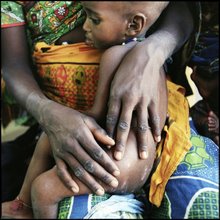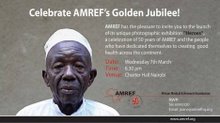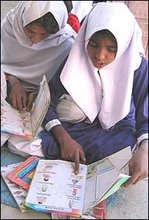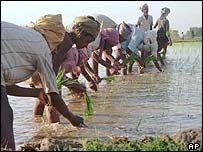PREAMBLE: On cloudless nights in 1957, children lay on their backs searching for a small red object traversing the sky: the Soviets had launched “sputnik”, the world’s first satellite. Although this also led to accelerating the “space race” and intensifying the “cold war”, imaginations everywhere were captivated by our common primordial fantasy: reaching for the stars. In the same year, three surgeons in Kenya, Michael Wood, Archibald McIndoe and Thomas Rees had a vision that could revolutionize health care in Africa. Sharing in the romance of Africa, its needs, its potential and sense of destiny, they launched a Flying Doctor Service. Over the next 5 decades, men set foot on the moon, satellites explored our solar system, the universe probed was probed with powerful orbital telescopes, robots explored the surface of Mars, and shuttles began servicing an international space station. In the meantime, what began as the Flying Doctor Service became Africa’s largest indigenous health organization: the African Medical and Research Foundation.
Yet, even as we make progress in solving the riddles of the universe, there remains extreme poverty and ill-health throughout Africa, and injustice throughout the world. In this, its 50th anniversary year, we celebrate the AMREF story which continues to unfold. In doing so we have drawn from our opportunity to view the organization at work during a joint donor evaluation in 2005-6, and from their anniversary book A Very African Journey (URL at foot of this article).
THE AMREF STORY
AMREF’s Vision is to seek “better health for Africa”. Its Mission states… “In creating vibrant networks of informed communities that work with empowered health workers in stronger health systems, we aim to ensure every African has access to the good health which is theirs by right.”
Over the past half century, AMREF has truly evolved. Prior to the 1970s, most of its work was service delivery. Under then-chairman, Dunstan Omari (former secretary to the East African Community), the concept of community-based health care was promoted. Advocated by then-lecturers at Nairobi University, Roy Shaffer and Miram Were (now Chair of AMREF), and implemented by Revi Tuluhungwa, Chris Wood and others, a strategy of working more closely with Ministries of Health took root. Since then, AMREF has trained Africans to staff the organization, relying steadily less on foreigners to carry out its work, just as it has been training community health workers for many African governments. Its Flying Doctor Service is now a self-sustaining entity, while AMREF itself still delivers an outreach programme to support essential care and training to rural hospitals. AMREF initiated and now runs community-based programmes in Kenya, Tanzania, Uganda, Ethiopia, Somalia, Sudan and South Africa. Increasingly it has emphasized education, innovation and research, working in partnership with communities, grassroots organizations, governments and donors. It concentrates on finding ways to improve health through projects that address Africa’s unique problems, taking into account: culture, attitudes, economies, politics and environment as critical factors. Based on evidence supported by its operational research, AMREF’s programmes serve as implementation models for Africa, influencing policies and practices by sharing its interventions across the continent.
For decades, AMREF has applied ecosystems principles in the identification of health risks and piloting appropriate health system solutions in rural areas. On the dry plains, trachoma (leading infectious cause of blindness) persists among the Masaai in an environment of little water and swarms of flies; this contrasts with a farming community nestled between two rivers only 15 kilometres away: here trachoma is absent and malaria hyperendemic (where water is plentiful, mosquitoes breed more readily). Clearly, differing environments in conjunction with human behaviour combine to determine health risks. Overlaid on a traditional culture in which each wife shares a one-room home with her children and newborn animals, preparing meals on a contaminated floor, it is in these settings that conditions such as trachoma must be tackled. The WHO “SAFE” protocol was adopted: surgery, antibiotics, face-washing, and environmental improvements. From a primary prevention perspective, the underlying priority is the reverse of this, but one must deal with the most seriously affected first, as this gains immediate attention and promotes the credibility of an integrated approach. Attending to environmental and personal hygiene are also prerequisites to the prevention of a much wider range of conditions. Simple interventions like “leaky tin technology” (a large can of water with a small hole at its base plugged by a thorn), so that clean water can remain uncontaminated and used sparingly, have made the difference in reducing exposure and transmission of such diseases. Two decades ago AMREF realized that episodic clinical teams weres neither effective nor efficient, and that a community approach was needed, emphasizing the role of women. Adopting the WHO “PHASE” campaign (personal hygiene and sanitation education) in 1995, and in partnership with Glaxo Smith Kline, AMREF pioneered this approach in Kenya and Uganda; this has been replicated elsewhere in the world eg., Peru, Tajikistan, Nicaragua, Bangladesh.
AMREF’s operational activities reflect Africa’s disease burdens at the grassroots, including malaria and HIV. For example, the Malaria Partnership Programme in Uganda involves AMREF, Ministries of Health and local NGOs with funding from Glaxo, Smith, Kline. In Kiboga, Kanungu and Kumi districts, AMREF has trained over 1,000 “community medicine distributors” (CMDs) to promote insecticide-treated bednet use and home-based fever management in children who previously would have been treated with ineffective drugs purchased from roadside vendors. Population Services International has underwritten the distribution of nets, using a revolving fund. Within 3 years, 80% of children with malaria in these districts benefited from CMD interventions, supported by AMREF-trained clinical officers, nurses and laboratory technicians, and a marketing effort using radio broadcasts, drama and music, as well as posters in shops, schools and churches. In response to the HIV epidemic, the “Angaza Project” (Swahili: “shed a light”) in Tanzania has implemented 47 counseling and testing sites (more in development), and almost 1,000 counselors trained, supported by a marketing effort using peer educators, music and sports: 0.5 million people have already been tested.
AMREF is intimately involved in health systems development in difficult urban settings. As stated by Director-General Dr Michael Smalley: “If health systems are robust then everything else works”. For example, in the Kibera slum nearby Nairobi, a squatter community of some 850,000 live in extreme poverty and overcrowding, in grossly deficient housing and poor environmental conditions. This situation is found in many cities throughout Africa, due to the rural to urban shift of populations. Such shanty-towns are becoming home to 2nd and 3rd generations, and are virtually a permanent feature of these cities. As migrants come from differing backgrounds and cultures, there is ethnic tension and little community solidarity. Nonetheless, it is precisely in this setting that AMREF has been working in close collaboration with the community-based organization Mradi ya Afya Msingi na Maendeleo (MRAMMA), to develop Primary Health Care (PHC), in a manner that reflects the spirit of the Alma Ata Declaration (1978), the most enduring set of principles for PHC development. In partnership for 11 years, the project has reached 100,000 slum dwellers, including such interventions as community organization and leadership development, stimulation of small enterprises, provision of safe water and sanitation, a core package of PHC interventions emphasizing maternal and child health, and a health centre to deal with a range of conditions responsible for the bulk of the disease burden. This community-based effort has succeeded so well that the City of Nairobi, the Ministry of Health and other partners have now joined to uplift the conditions of Kibera.
Among AMREF’s most important roles is the management of knowledge: building capacity through training, and introducing new learning systems. Since 1987, AMREF has run a 1-year diploma in community health, now offered in affiliation with Kenya’s Moi University. Through this rigorous programme have passed almost 500 students from 35 African countries. Innovative ways have also been found to exercise this role in a distributed manner, eg., almost 10,000 students have taken AMREFs correspondence courses. In 1998 the Maridi National Health Institute was started in southern Sudan with AMREF funding and support: this is a 3 year” clinical officer” course, through which over 130 graduates have been trained to become first line practitioners. New learning methods and technologies are being utilized: increasingly teaching is based on the PBL approach (problem-based learning), and an e-learning initiative has been launched in collaboration with the Nursing Council of Kenya with support (funding and technical) from Accenture: to upgrade 22,000 nurses from certificate to diploma level.
Much more could be told about the work of AMREF than is possible in the space of this short report. In South Africa, where the Ministry of Health accepts traditional practitioners within the formal health system (>60% of South Africans consult sangomas), AMREF is working to help determine “best practices”, and to promote the integration of sangomas within health priorities such as HIV counseling, TB treatment, oral rehydration therapy, and checking on immunization status, while also supporting safe and more effective traditional practices. Elsewhere in Africa eg., Kechene District, Ethiopia, AMREF is supporting microcredit schemes for families, simultaneously addressing poverty and health: helping women to develop economically viable small enterprises and to take care of their familes at the same time. In conflict zones eg., northern Uganda and southern Sudan, AMREF is working “to have health systems and informed communities ready to take control of their own lives and… health, once the fighting is over”.
Conclusion: AMREF recognizes far better than most health organizations around the world that 80% of health is made in households and communities; perhaps only 20% is repaired in hospitals and clinics. Redressing the imbalance in Africa requires empowering communities, teaching preventive measures in a way that can be understood, and narrowing the gap between health systems and communities. Priority must be given to operational and applied research: AMREF’s own priorities are development driven, and a research question embodied within all proposals to donors. From this research comes policy making: AMREF sees itself at the interface in this critical process. AMREF’s current 5 year strategy (2006-11) is to strengthen health systems and to provide the evidence. As stated by AMREF Chair, Professor Miriam Were: “In the past we just assumed that people would see how passionate and experienced we were and follow. Now we know it takes hard-nosed science to persuade others… we are beginning to produce the evidence to influence policy-makers”.
Reference: A Very African Journey is available on-line at: http://64.176.64.243/A%20Very%20African%20Journey.pdf
For more about AMREF, visit their website: http://www.amref.org/
FROM a Great Canadian and World Statesman
"A great gulf... has... opened between man's material advance and his social and moral progress, a gulf in which he may one day be lost if it is not closed or narrowed..."
Lester B Pearson
http://nobelprize.org/nobel_prizes/peace/laureates/1957/pearson-lecture.html
Sunday 1 July 2007
Subscribe to:
Posts (Atom)
INSPIRATIONAL WELCOME ............................... from T.S.Eliot's "Little Gidding"
If you came this way From the place you would come from... It would be the same at the end of the journey...
If you came, not knowing what you came for, It would be the same... And what you thought you came for Is only a shell, a husk of meaning... From which the purpose breaks only when it is fulfilled If at all.




















